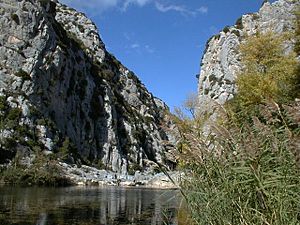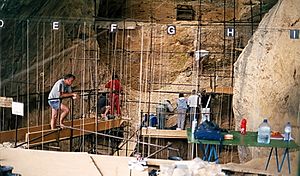Arago cave facts for kids
Quick facts for kids Arago cave |
|
|---|---|
| Caune de l'Arago | |

Excavation at the cave
|
|
| Location | Occitanie (région administrative) Département des Pyrénées-Orientales Massif des Corbières dans les pré-Pyrénées |
The Arago Cave is a super old and important place in Tautavel, France. It's a big cave that looks over a river called the Verdouble. Scientists have found amazing things here, like bones from ancient humans called the Tautavel Man and lots of old stone tools. These discoveries tell us a lot about how people lived a very, very long time ago!
Contents
Where is Arago Cave?
The Arago Cave is in the south of France, near the Pyrenees mountains. It's located in a town called Tautavel. The cave is part of a big limestone cliff in the Corbières Massif. It sits high above a wide valley where the Verdouble river flows.
The cave itself is about 30 meters (almost 100 feet) long today. But long ago, it might have been much longer, perhaps up to 120 meters! It's also about 10 meters (33 feet) wide.
This cave was a perfect home for ancient Hunter-gatherers. It faced east, which meant it got lots of sunlight and stayed warmer in winter. The area around the cave had many different environments. This meant there were lots of different animals to hunt.
- Animals near the river included beavers.
- Animals in the plains included deer, horses, bison, rhinos, and elephants.
- Animals on rocky hills included mouflons, ibex, and chamois.
- Animals in colder, higher areas included musk oxen and reindeer.
A shallow part of the river nearby was a great spot for hunting. Large groups of animals would cross there. The cave's high spot also gave hunters a great view to spot herds. The river always had water and provided useful pebbles for tools. People also found other stones for tools, like flint and red jasper, from places up to 30 kilometers away. This shows they knew their area well!
Why is Arago Cave Important?
The Arago Cave is special because it has over 15 meters (about 50 feet) of dirt, rocks, and old remains. These layers built up over a huge amount of time, from about 100,000 to 700,000 years ago!
Scientists have found about 260,000 items here, including bones and stone tools. These discoveries give us tons of information. They tell us about the ancient humans who lived there. They also teach us about the animals, plants, and climates that changed in the region over 600,000 years.
On July 27, 2015, young volunteers found a tooth at the site. This tooth was 550,000 years old! That makes it 100,000 years older than the famous skull of the Tautavel Man.
The Tautavel Man
The Tautavel Man is a very old type of human, a kind of Homo erectus. Scientists found his 450,000-year-old fossil remains in the Arago Cave. These fossils are super important for understanding human history.
Animals and Plants of the Past
Scientists have found remains of 122 different kinds of animals in the Arago Cave! Many of these were mammal species that ancient humans hunted and ate.
- A type of horse (Equus mosbachensis tautavelensis) was a main food source for the Tautavel Man.
- Many Bison priscus (an ancient type of bison) were also found.
- Other animals found include reindeer, deer, fallow deer, musk oxen, mouflons, tahrs, and rhinos.
- Remains of Deninger bears (Ursus deningeri) were also discovered.
How the Cave Was Discovered and Explored
People knew about the Arago Cave since the mid-1800s because of animal bones found there. But in 1948, J. Abelanet found the first signs of ancient human tools. In the 1950s, amateur archaeologists like the Ribes de Maury brothers and Raymond Gabas started digging. They worked with J. Abelanet. Their findings showed how important and rich the site was.
Since April 1964, systematic digs have happened every year. These digs are led by Henry de Lumley. At first, the digs lasted only two weeks. Then they grew to one month, then three months, and since 1992, they last five months each year! The Arago Cave was officially recognized as a historic monument in April 1965.
Layers of Time in the Cave
The cave floor has about ten meters (33 feet) of layers. These layers cover most of the Middle Pleistocene period. Scientists have tried to figure out the exact age of these layers using different methods. For example, they used a method called Uranium–thorium dating to find ages of about 700,000 years for the bottom layers and 350,000 years for the top layers.
The most important archaeological finds are in layers D to G. These layers are thought to be between 300,000 and 450,000 years old. Many human fossils were found here. This includes a skull (Arago XXI) and two jawbones (Arago II and Arago XIII). These are all from the Tautavel Man.
The tools found in the oldest layers of this section are called "Tayacian" or "Tautavélien." They are mostly made of quartz, and sometimes flint or quartzite. These tools include scrapers and many tools with notches, like denticulates. There are also some rare hand axes. In the higher layers (layer E), there are more hand axes. This led Henry de Lumley to connect these tools to the Middle Acheulean period.
Most of the materials used for tools (about 80%) were found nearby in the Verdouble river. But some materials came from areas up to 30 kilometers away. This shows that the ancient people knew their region well and planned ahead for their tool-making needs.



